You know that familiar scene – it's 5 AM, still dark outside, and you're sitting at your favorite tapsihan, hands wrapped around a steaming bowl of Arroz Caldo while watching the city slowly wake up. That's been my morning ritual since college.
After years of trying to recreate that perfect street-side taste at home, I've finally mastered this homemade arroz caldo recipe that rivals even my go-to karinderia's version. That perfect balance of luya (ginger) that clears your sinuses, tender chicken pieces that practically melt in your mouth, and those golden bits of crispy garlic that I always ask for extra servings of (admit it, we all do!).
I've spent countless early mornings perfecting this recipe, and now my kids actually request this instead of cereal, a win for Filipino breakfast if you ask me!
This arroz caldo recipe will become your new comfort food go-to. Once you learn how to make this at home, those 5 AM tapsihan runs might become less frequent. But hey, at least your wallet will thank you.
Jump to:
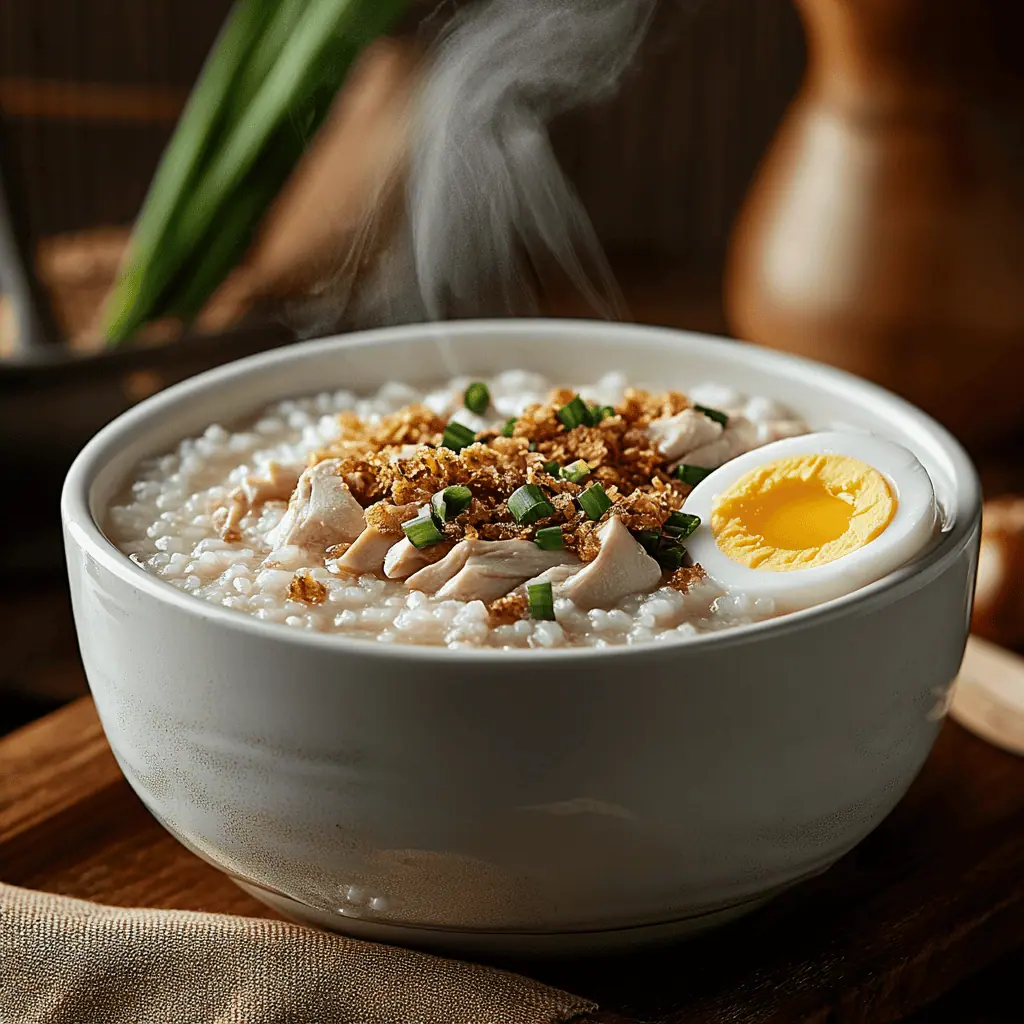
Why You'll Love This Recipe
- Healing Properties: Packed with ginger and garlic, this congee is known as "Filipino penicillin
- Budget-Friendly: Uses simple pantry staples to create a filling meal
- Customizable: Easy to adjust consistency and toppings to your preference
- Make-Ahead Friendly: Perfect for batch cooking and reheating
- All-Weather Comfort: Ideal for rainy days, sick days, or any time you need comfort food
- Restaurant-Quality: Better than many carinderia versions!
Ingredients
These ingredients create the ideal balance of flavors and textures that make arroz caldo so beloved. Whole chicken provides rich flavor and tender meat, while uncooked rice breaks down to create the porridge's signature creamy consistency.
Fresh ginger and garlic form the aromatic base that gives this dish its healing properties, with fish sauce adding that essential umami depth. The garnishes—crispy fried garlic, green onions and hard-boiled eggs, add contrasting textures and visual appeal, while calamansi or lemon wedges provide brightness that cuts through the richness.
Together, these simple ingredients transform into a comforting bowl that has nourished generations of Filipinos through cold mornings, rainy days, and times of illness.
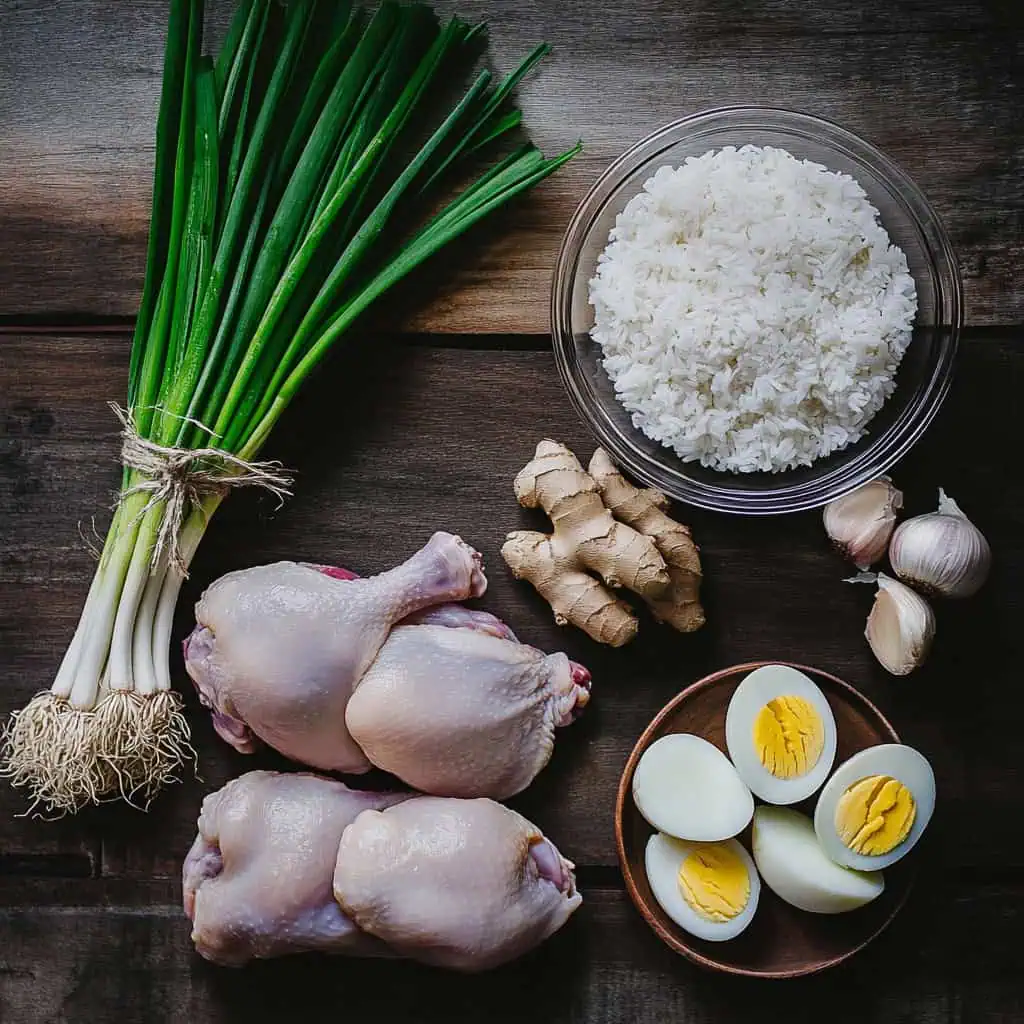
- 1 (3-4 pound) whole chicken, cut into serving pieces
- 1 cup uncooked rice
- 1 large onion, chopped
- 4 tablespoons fresh ginger, minced
- 6 cloves garlic, minced
- 2 tablespoons fish sauce
- 6-8 cups chicken broth or water
- 2 chicken bouillon cubes
- Salt and pepper to taste
- 1 tablespoon cooking oil
- 6 hard-boiled eggs, halved
- ½ cup fried garlic bits
- ½ cup green onions, chopped
- Calamansi or lemon wedges
- Additional fish sauce for serving
- Optional: chili oil
Equipment
- Large Heavy-Bottom Pot: Essential for even heat distribution and preventing the rice from burning. A Dutch oven works perfectly.
- Sharp Knife: For properly cutting chicken into serving pieces.
- Cutting Board: Preferably use separate ones for meat and vegetables to prevent cross-contamination.
- Wooden Spoon: The best tool for stirring porridge without breaking rice kernels.
- Measuring Cups and Spoons: For accurate measurements of ingredients.
- Fine Mesh Strainer: For rinsing rice thoroughly before cooking.
- Ladle: For serving the porridge without making a mess.
- Deep Serving Bowls: Traditional way to serve this hot dish.
- Small Dishes: For serving condiments like fish sauce, calamansi, and chili oil.
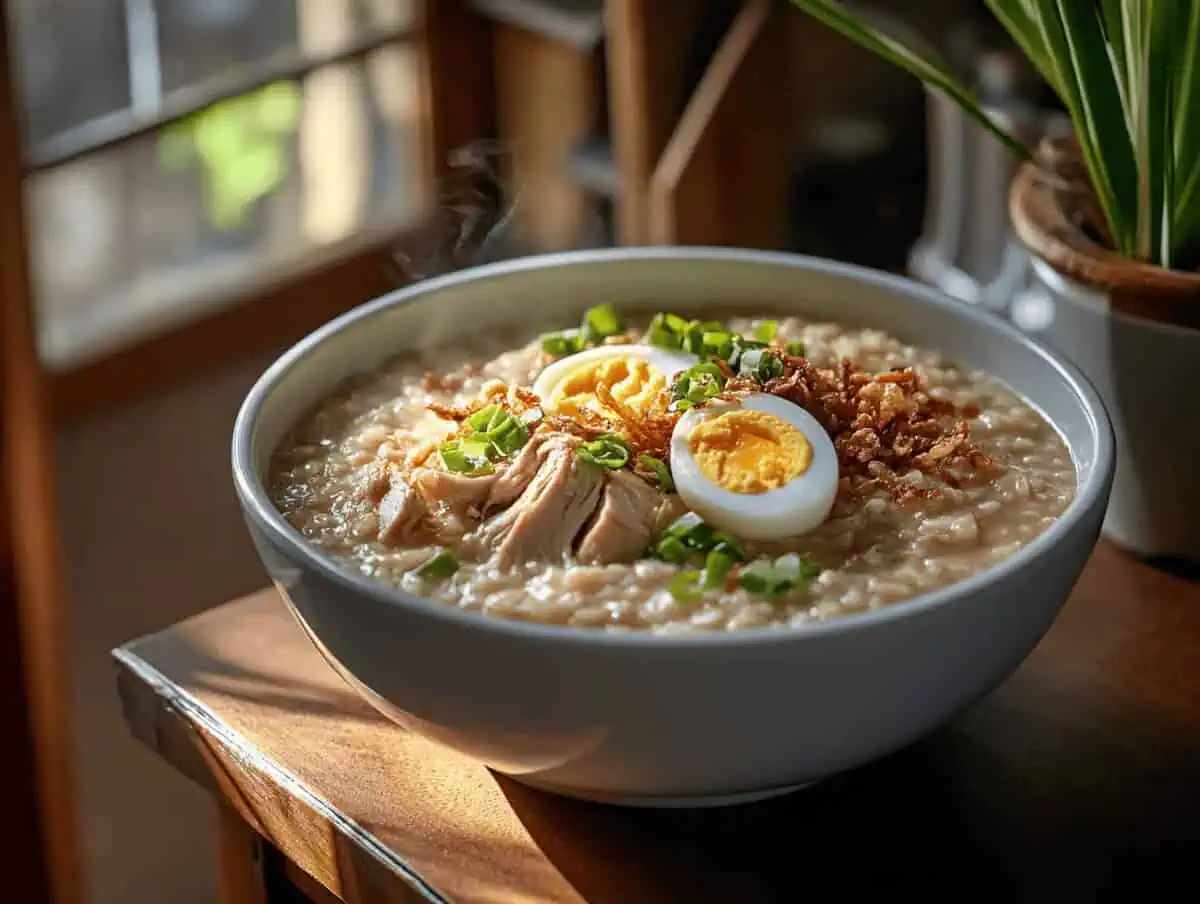
How To Make
- Clean your whole chicken thoroughly and cut it into serving pieces. Rinse your rice in cool water, swirling and draining until the water becomes clear (usually takes about three rinses). While the rice drains, finely chop your onions, mince the garlic, and grate the fresh ginger.
- Set your stove to medium heat (180°C/350°F) and place a large, heavy-bottomed pot on the burner. Pour in your cooking oil and let it warm up for about 30 seconds. Add your chopped onions to the hot oil and cook until they become transparent, which takes about 2 minutes. Now add your minced garlic and grated ginger, continuing to cook until fragrant, approximately 2 more minutes.
- Add your chicken pieces to the pot and cook until they turn slightly golden, about 5 minutes. Pour in the fish sauce and stir everything together, letting it cook for 2 more minutes to allow the flavors to meld.
- Add your washed rice to the pot and stir it with the chicken and aromatics for 1-2 minutes. Pour in 6 cups of your chicken broth or water. Increase the heat to high and bring everything to a boil. Once boiling, immediately lower the heat to a gentle simmer (160°C/320°F).
- Stir the porridge occasionally to prevent the rice from sticking to the bottom. Cook for about 20-25 minutes, or until the rice breaks down and creates a creamy consistency. If the porridge becomes too thick, add more hot broth or water, one cup at a time, until you reach your desired consistency.
- Add your chicken bouillon cubes and stir until they dissolve completely. Taste your arroz caldo and add salt and pepper as needed. The consistency should be thick but still flowing, similar to a creamy soup.
- Prepare your toppings while the arroz caldo finishes cooking. Chop your green onions, slice your hard-boiled eggs in half, and make sure your crispy garlic is ready. Cut some calamansi or lemon wedges for serving.
- Serve your arroz caldo piping hot in deep bowls. Place the eggs, chopped green onions, and crispy garlic on top. Set out small dishes of additional fish sauce and calamansi wedges so everyone can adjust the seasoning to their taste. For those who enjoy spice, offer chili oil on the side.

Tips from Lola's Kitchen
- Use day-old rice for better texture and faster breakdown into creamy consistency.
- Toast the rice grains in oil before adding liquid for a nuttier, more complex flavor.
- Add ginger gradually - you can always add more but can't take it away. Start with half the amount and taste as you go.
- Reserve some chicken broth to adjust consistency while cooking. Keep it hot and ready.
- For extra richness, add a tablespoon of butter right before serving.
- Cook at a gentle simmer, not a rolling boil, for the creamiest texture.
- If using bone-in chicken, remove the pieces when tender, shred the meat, and return it to the pot.
- For maximum flavor, use homemade chicken stock instead of bouillon and water.
Substitutions
- Rice: Regular white rice works best, but you can use glutinous rice (malagkit) for an even thicker consistency. Brown rice works too but requires more liquid and longer cooking time.
- Chicken: Turkey or bone-in pork can be substituted. For a quicker version, use boneless chicken thighs.
- Calamansi: Lemon or lime will work, though the flavor profile will be slightly different.
- Fresh ginger: This is a key ingredient that shouldn't be substituted. In an absolute emergency, use 1 tablespoon ground ginger, but the flavor won't be the same.
- Fish sauce: Light soy sauce can work but reduce the amount by half and adjust salt accordingly.
- Bouillon cubes: Use 2 additional cups of good quality chicken stock instead.
Troubleshooting
- Porridge too thick: Add hot chicken broth or water gradually while stirring until you reach desired consistency. Remember it will continue to thicken as it sits.
- Porridge too thin: Continue cooking uncovered while stirring frequently to evaporate excess liquid. Alternatively, add a few tablespoons of pre-cooked rice.
- Rice not cooking evenly: Lower heat and stir more frequently. Make sure you're using the proper rice-to-liquid ratio (1:6 minimum).
- Burning on the bottom: Immediately transfer to another pot without scraping the burnt portion. Lower your heat and stir more frequently next time.
- Not flavorful enough: Add more fish sauce, increase ginger amount, or boost with additional bouillon. Remember to season properly with salt.
- Chicken not tender enough: Continue cooking at a low simmer until the meat easily falls off the bone.
Storage & Reheating
- Refrigerate: Store in an airtight container for up to 3 days. The porridge will thicken considerably in the refrigerator.
- Freeze: Portion into freezer-safe containers without garnishes and freeze for up to 2 months.
- Reheating: Add ¼ to ½ cup water or broth per portion while reheating over low heat, stirring frequently. Microwave reheating works too - heat in 1-minute intervals, stirring between each.
- Make-ahead tip: If preparing for later, make the porridge slightly thinner than desired as it will continue to thicken when cooled.
- Garnishes: Always add fresh garnishes after reheating, never before storing.
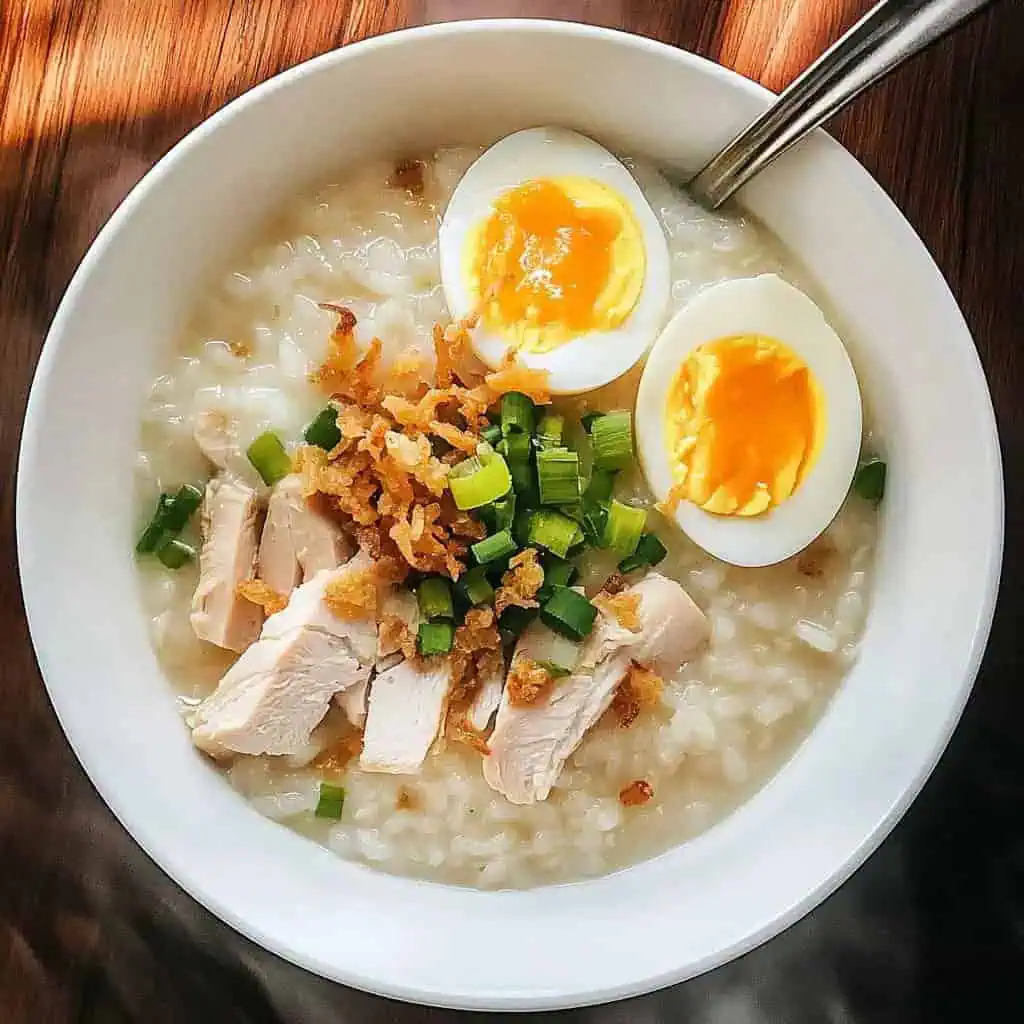
FAQ
Can I make this in an Instant Pot?
Yes! Use the "Sauté" function for steps 2-3, then add remaining ingredients and cook on high pressure for 20 minutes with natural release. Use a 1:8 rice to liquid ratio as less evaporation occurs.
Why is my arroz caldo too bland?
This usually happens when you don't use enough ginger, fish sauce, or salt. Make sure to use plenty of fresh ginger and season adequately. The bouillon cubes are also important for depth of flavor.
Can I make this ahead for a party?
Absolutely! Make it slightly thinner than usual as it will thicken when cooled. Store the porridge and garnishes separately, then reheat and assemble just before serving.
Is this good for sick people?
Yes, it's considered Filipino comfort food and often served to those feeling under the weather. It's high in nutrients, easy to digest, and the ginger helps with nausea or congestion.
Can I use other parts of chicken?
Yes, chicken thighs work especially well. Breast meat is leaner but can become dry if overcooked. Wing portions add great flavor from the bones.
How do I store leftover fried garlic?
Keep it in an airtight container at room temperature for up to a week. It's great for topping other dishes too!
What's the difference between arroz caldo and lugaw?
Lugaw is the basic rice porridge, while arroz caldo specifically includes chicken and more aromatics. Goto is another variation made with beef tripe.
Can I make this vegetarian?
Yes, use vegetable stock instead of chicken broth, omit the chicken, and add mushrooms, tofu, and more vegetables for substance.
Related
Looking for other recipes like this? Try these:

Filipino Arroz Caldo (Lugaw na Manok)
Ingredients
For the Porridge Base:
- 1 3-4 pounds whole chicken, cut into serving pieces (manok)
- 1 cup uncooked rice bigas
- 1 large onion chopped (sibuyas)
- 4 tablespoons fresh ginger minced (luya)
- 6 cloves garlic minced (bawang)
- 2 tablespoons fish sauce patis
- 6-8 cups chicken broth or water
- 2 chicken bouillon cubes
- Salt and pepper to taste
- 1 tablespoon cooking oil
For the Garnish (Sahog):
- 6 hard-boiled eggs halved (itlog)
- ½ cup fried garlic bits
- ½ cup green onions chopped (dahon ng sibuyas)
- Calamansi or lemon wedges kalamansi
- Additional fish sauce for serving patis
- Optional: chili oil langis ng sili
Instructions
- Start by cleaning your whole chicken thoroughly and cutting it into serving pieces (linisin at hiwain ang manok). Next, rinse your rice in cool water, swirling and draining until the water becomes clear (banlawan ang bigas hanggang maging malinis ang tubig). This usually takes about three rinses. While the rice drains, finely chop your onions (sibuyas), mince the garlic (bawang), and grate the fresh ginger (luya).
- Set your stove to medium heat (katamtamang init, 180°C/350°F) and place a large, heavy-bottomed pot on the burner. Pour in your cooking oil (mantika) and let it warm up for about 30 seconds. Add your chopped onions to the hot oil and cook until they become transparent (hanggang maging malinaw), which takes about 2 minutes. Now add your minced garlic and grated ginger, continuing to cook until you can smell their fragrant aroma (hanggang mabango), approximately 2 more minutes.
- Add your chicken pieces to the pot and cook until they turn slightly golden (hanggang mamutla ang kulay), about 5 minutes. Pour in the fish sauce (patis) and stir everything together, letting it cook for 2 more minutes to allow the flavors to meld (hanggang magsamang mabuti ang lasa).
- Now add your washed rice to the pot and stir it with the chicken and aromatics for 1-2 minutes. Pour in 6 cups of your chicken broth or water. Increase the heat to high and bring everything to a boil (pakuluan). Once boiling, immediately lower the heat to a gentle simmer (hinaan ang apoy, 160°C/320°F).
- Stir the porridge occasionally to prevent the rice from sticking to the bottom (haluin paminsan-minsan para hindi dumikit ang kanin). Cook for about 20-25 minutes, or until the rice breaks down and creates a creamy consistency (hanggang lumambot at lumapot ang lugaw). If the porridge becomes too thick (kung masyadong malapot), add more hot broth or water, one cup at a time, until you reach your desired consistency.
- Add your chicken bouillon cubes and stir until they dissolve completely (hanggang matunaw). Taste your arroz caldo and add salt and pepper as needed (timplahan ng asin at paminta ayon sa gusto). The consistency should be thick but still flowing, similar to a creamy soup.
- Prepare your toppings while the arroz caldo finishes cooking. Chop your green onions (dahon ng sibuyas), slice your hard-boiled eggs in half (itlog na maalat), and make sure your crispy garlic (sinangag na bawang) is ready. Cut some calamansi or lemon wedges for serving (kalamansi).
- Serve your arroz caldo piping hot (mainit-init) in deep bowls. Place the eggs, chopped green onions, and crispy garlic on top. Set out small dishes of additional fish sauce and calamansi wedges so everyone can adjust the seasoning to their taste (timplahan ayon sa gusto). For those who enjoy spice, offer chili oil on the side.
- To store any leftover arroz caldo, let it cool completely then place it in an airtight container. It will keep in the refrigerator for up to three days (maiimbak sa ref nang hanggang tatlong araw). When reheating, add a little hot water or broth to thin it out as needed, and heat over medium-low temperature while stirring occasionally (initin sa katamtamang apoy habang hinahalo paminsan-minsan).
Tips from Lola's Kitchen
- Use day-old rice for better texture
- Add ginger gradually - you can always add more
- Toast rice grains in oil before adding liquid for nuttier flavor
- Save some chicken broth to adjust consistency while cooking
- For extra richness, add a tablespoon of butter at the end
Nutrition
The Story Behind Filipino Arroz Caldo
Walking through any Filipino neighborhood at dawn, you'll likely catch the aromatic whispers of ginger and garlic wafting from local eateries (karinderya), where steaming pots of arroz caldo have been comforting souls for generations. While its Spanish name "arroz caldo" (meaning "rice soup") might suggest colonial origins, this beloved Filipino rice porridge tells a far richer story of cultural integration.
Long before the Spanish arrived in the Philippines in the 16th century, Chinese traders and settlers had already introduced congee (rice porridge) to the archipelago. The local version, known as "lugaw," became a staple in Filipino households, particularly during the monsoon season. When Spanish colonizers arrived, they encountered this dish and dubbed it "arroz caldo," adding their own linguistic touch to what was essentially a Chinese-inspired creation.
The genius of Filipino cuisine lies in its ability to adapt and enhance, and arroz caldo perfectly exemplifies this. While Chinese congee often maintains a subtle flavor profile, Filipino cooks transformed it by incorporating native ingredients like pungent ginger (luya), golden fried garlic (sinangag na bawang), and the uniquely Filipino calamansi citrus. The addition of fish sauce (patis) brought in that distinctive umami depth that's quintessentially Southeast Asian.
In modern Filipino culture, arroz caldo transcends its humble origins to become something truly special. You'll find it served at morning markets (palengke) as breakfast for early risers, ladled into bowls at street corners during rainy seasons, and lovingly prepared in homes when family members are feeling under the weather. It's often jokingly referred to as "Filipino penicillin" for its reputation as a cure-all comfort food.
Today's home cooks and street vendors often reminisce about their grandmothers' (lola's) versions, each claiming a secret ingredient or special technique. Some swear by adding safflower (kasubha) for color, others insist on using native chicken (native na manok) for its superior flavor, and many have their own precise ratio of ginger to garlic that's been passed down through generations.
Whether you're enjoying it for breakfast (almusal), as a midnight snack (merienda), or as a comforting meal on a rainy day (pampatulog), arroz caldo remains a testament to the Philippines' rich culinary heritage. It's a dish that has witnessed centuries of cultural exchange, adapted to local tastes, and emerged as something uniquely and proudly Filipino – a true comfort food that tells the story of a nation's history in every steaming bowl.
The beauty of arroz caldo lies not just in its flavors but in its accessibility. From humble carinderias to high-end Filipino restaurants, from simple home kitchens to celebrity chef interpretations, this dish demonstrates how the most basic ingredients can be transformed into something extraordinary through time-honored techniques and a lot of love.



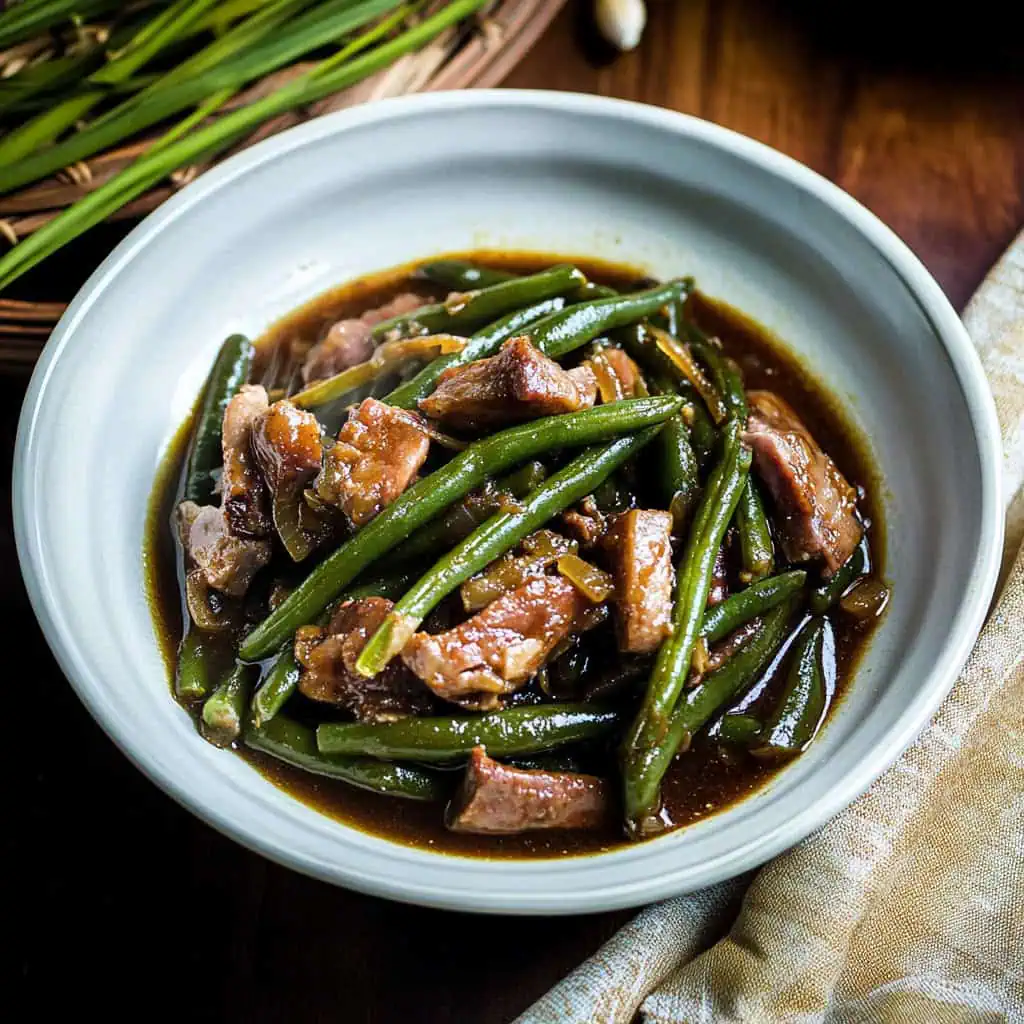

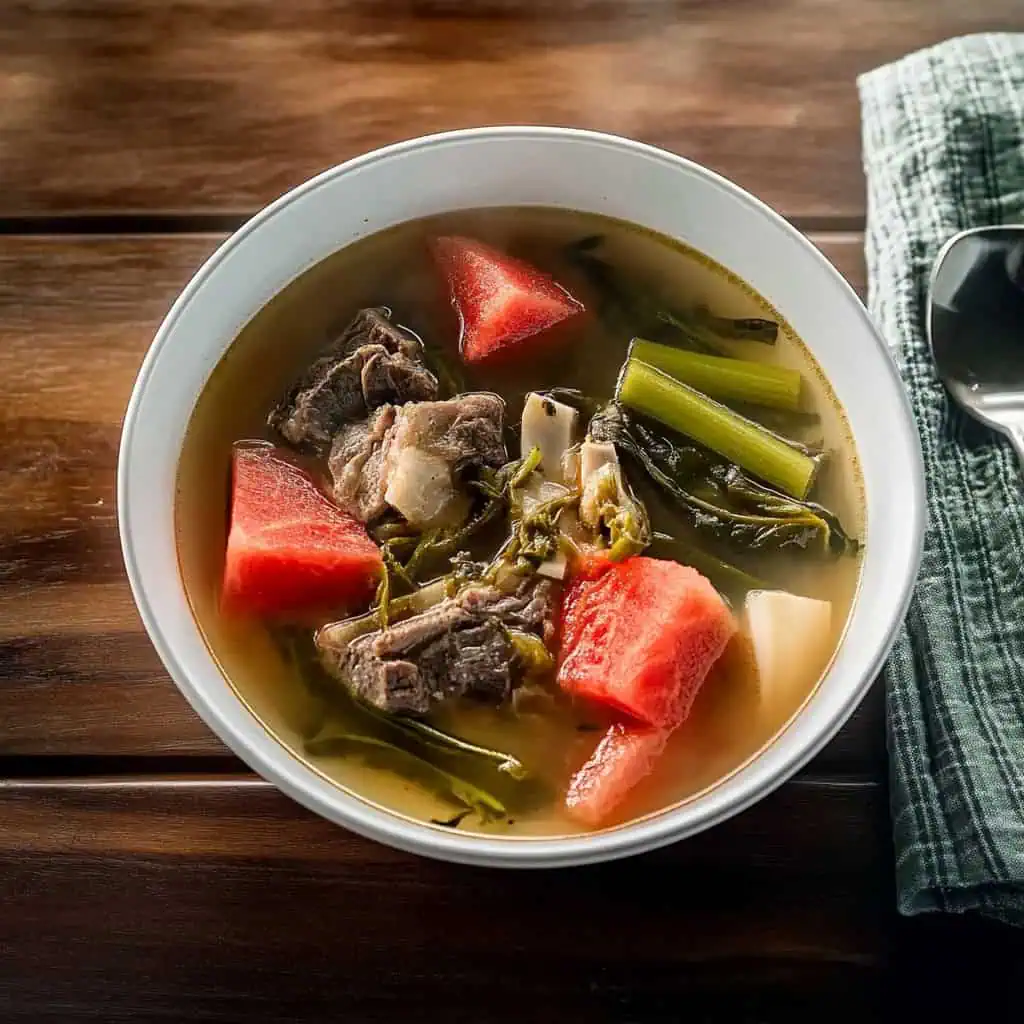


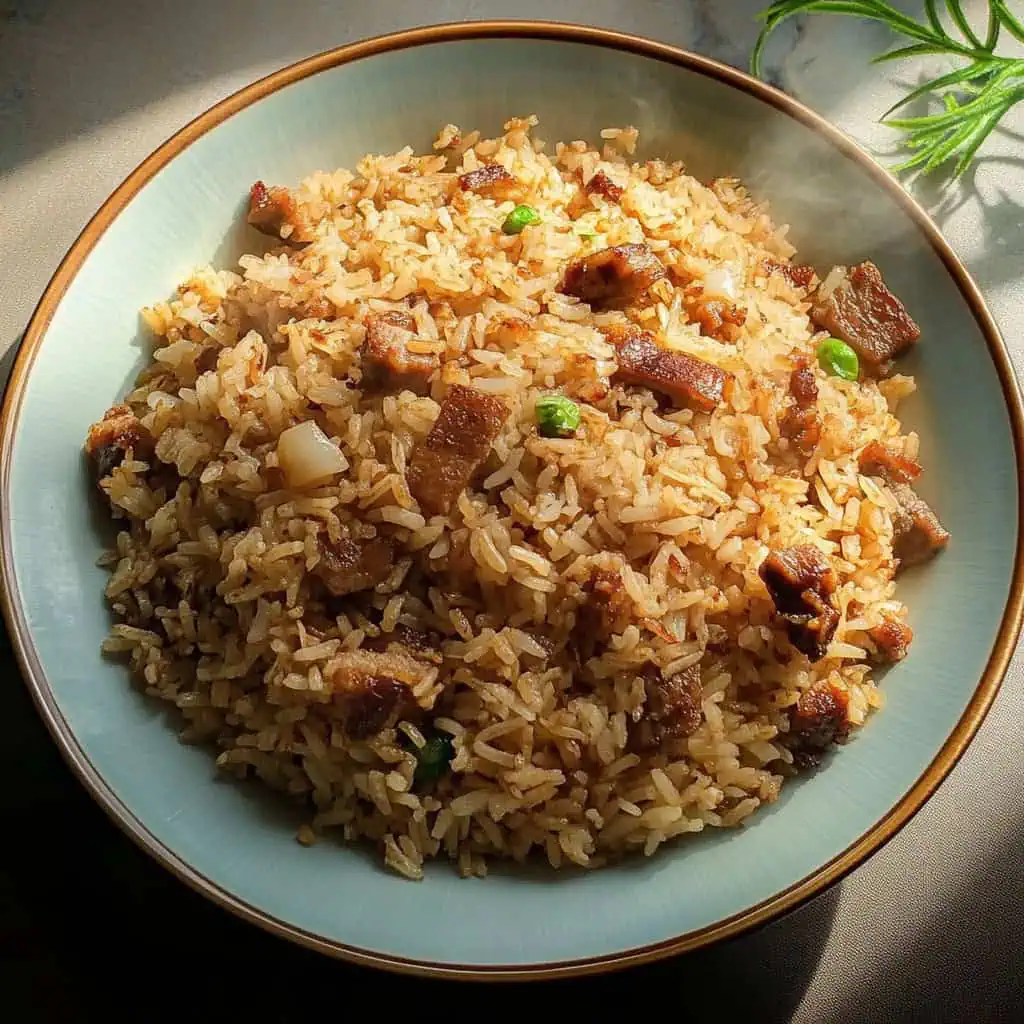
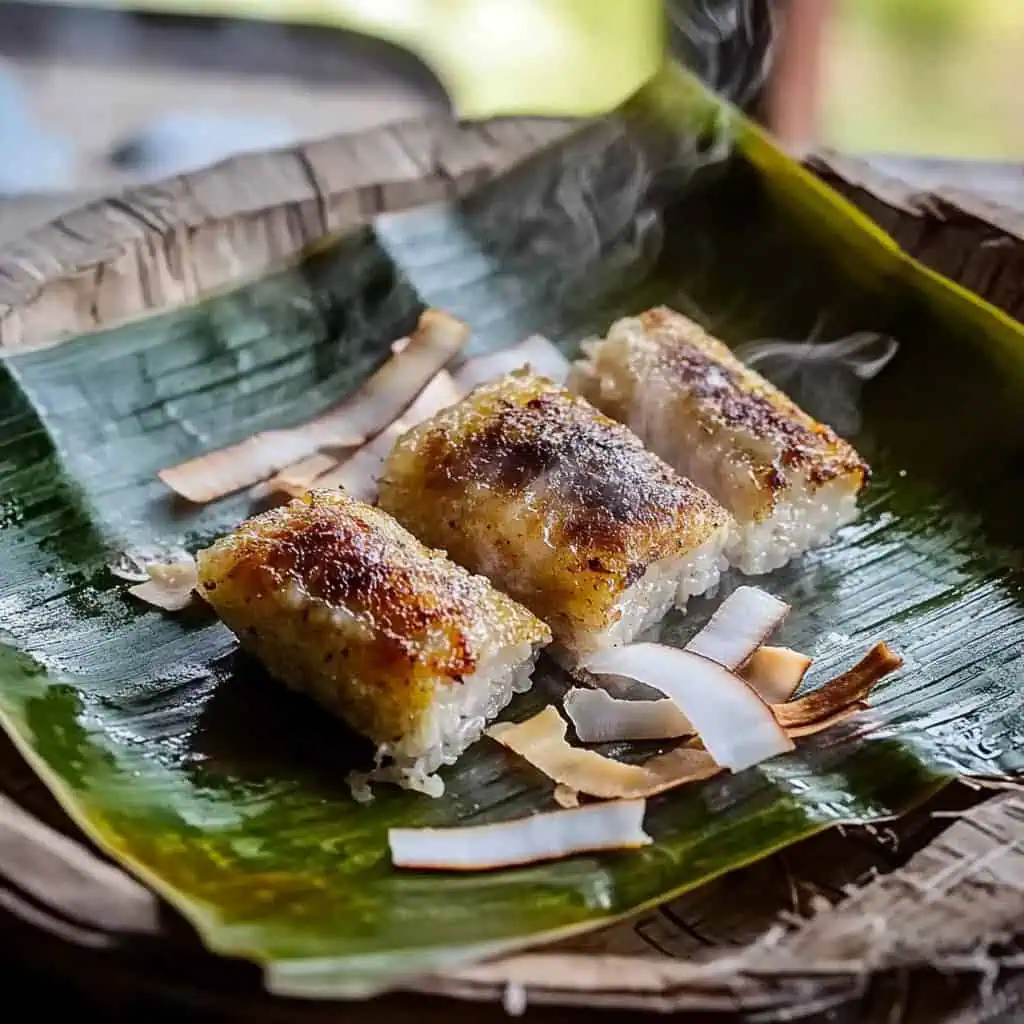
Comments
No Comments